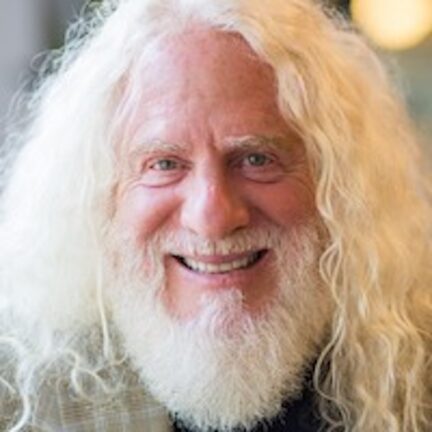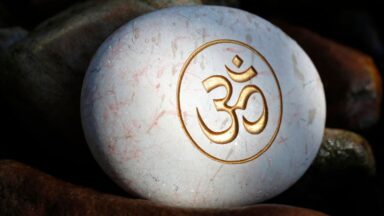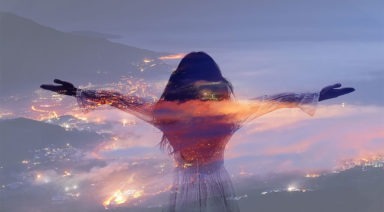What’s in a Mantra?

Most yogis know that chanting Om is chanting a mantra and that the word mantra comes from two Sanskrit words: man meaning mind; and tra meaning vehicle or instrument – a tool to transport the mind from a state of activity to one of stillness and silence. We get the words train, travel, and transportation from the Sanskrit root tra. But Om is not simply a word – it’s a seed sound known as a bija – heralding all of the unbounded universe in its very utterance. So let’s dive into the deep end of the mantra pool!
Most mantras are comprised of the fifty letters of the Sanskrit alphabet and can consist of a single letter, a syllable or string of syllables, a word, or a whole sentence. Typically, most mantras are sounds, syllables, or vibrations that don’t necessarily have a meaning. Their value lies in their vibrational quality, not in any meaning that humans, society, culture, or civilization has placed on them over the last few thousand years. For this reason they go beyond the state of human existence on this planet, and they take you deeper because they are vibrations that have existed since the dawn of creation.
The Hymn of the Universe
Om – often referred to as the hymn of the universe – is considered the ultimate vibration because it contains every vibration that has ever existed and every vibration that will ever exist. It’s pure yoga – union. Just as white light contains all the colors of the spectrum, Om contains every sound in the vibrational spectrum – even those we can’t hear with our ears. The cover of Pink Floyd’s Dark Side of the Moon represents this brilliantly as it shows the white light coming into a prism and all the colors of the spectrum coming out the other side. The same could be said for Om – it’s the white light of sound.
Historically, Om is first mentioned in the twelve verses of the ancient Vedic text the Mandukya Upanishads, which explains the three basic states of consciousness: waking, sleeping, and dreaming. In its original spelling and pronunciation, AUM (pronounced ahh-uhh-mmm) is a blending of those three states of consciousness into the one-ness of three distinct syllables: A, U, and M. These three vibrations also represent the three stages of life: birth, living, and death.
The vibration A (pronounced ahh, like the sound you make opening your mouth for the doctor) represents the waking state and the beginning of all things. The letter A is the first letter of most every alphabet, the first letter of the Rig Veda, the Koran, Homer’s Odyssey – even the New Testament! The vibration A heralds creation…the beginning. Vedic sages refer to it as the a-kara and it represents the realm of form and shape – the physical realm.
The vibration U (pronounced oo) is referred to as the u-kara and represents the dream state, the realm that is devoid of form or shape – the realms of air, water, fire, dreams – ever-changing aspects of the formless world around us.
The vibration M is known as the ma-kara, which represents the state of deep sleep – neither form or formless like the other two realms but beyond shape or shapelessness – the realm of consciousness in hibernation, waiting to unfold.
In Sanskrit grammar, when the letters A and U are combined in writing, they are translated as the letter O. That is why we so often see Om written instead of Aum. Over thousands of years, the writing of Aum has taken a back seat to Om, and that has led to Om being the sound that is most often chanted by both Western students and teachers of yoga, meditation, and Vedanta.
When the three individual vibrations are combined, a fourth vibration is created like a chord in music made up of individual notes. AUM (pronounced ahhh–uhhh–mmmm) represents the fourth state of consciousness – transcendent consciousness or turiya – what we call enlightenment or one-ness. In Vedanta, it’s the unity of the divine made up of its three components: creation; preservation; destruction (and rebirth). The chanting of this mantra heralds our universality, which is why we usually chant Om before and/or after meditation and yoga practice, and when we read sacred, ancient texts. By repeating a vibration or sound over and over, it will become part of your physiology; it will become your mind; it will become *you. * It will lose all meaning, all definition, and all relevance. There will be no separation between you and the vibration that is resonating right now.
Chanting Om (out loud or silently) is an ideal reminder of our universality.
3 Magical Mantras to Boost Your Prosperity

There is no shortage of prosperity in the world. It is a bottomless and self-replenishing cup from which we may all drink our fill. Unfortunately, self-defeating thoughts and negative self-talk can keep you from acknowledging all that is available to you and miss the opportunities that are all around you. Change those thoughts, however, and you invite the things you desire to come to you of their own accord.
With these powerful prosperity Mantras you will open up your mind and tap into the Universe and its unlimited source of abundance. Repeat these Mantras as you breath deeply, slowly and relax. With each repetition you will be reprogramming your subconscious mind to remove limiting beliefs and clear a path for wealth and prosperity to find you.
By using theses Magical Mantras throughout the week you will:
- Clarify your true financial desires.
- Throw off the shackles of your limiting beliefs that are keeping you stuck.
- Reprogram your subconscious mind to attract more prosperity into your life.
So now, if you’re ready, here are your 3 Mantras to attract more financial ease into your life. With your hands on your heart, repeat these three Mantras throughout the week and feel their vibrational energy entering in your being:
- I experience peace, happiness, prosperity, and wealth as an integral part of my life.
- It is completely safe, easy and natural for me to be prosperous and successful.
- Prosperity flows towards me every day and in every way.
If you want to “turbo-charge” these mantras, I suggest that you repeat them mentally for 5-10 minutes, while you are in a relaxing, quiet place with your eyes closed. This will put you in a light meditative state where your brain waves will slow down to the Alpha level. While in this state, your normally locked subconcious mind will be open to receive the suggestions, making the change in your thought patterns quicker and easier.
Alternatively, you can relax and listen to them through guided meditation and let your guide do all the work while your subconscious becomes rewired for abundance and prosperity.
Enjoy and let me know how you go!





































